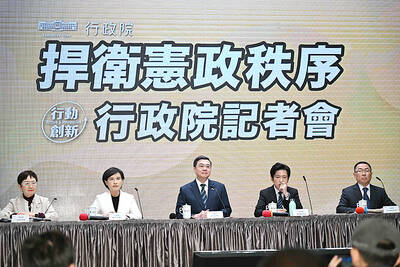Microsoft Corp yesterday announced that it would build an Azure data center in Taiwan, and create a new team focused on the research and development of artificial intelligence (AI) hardware.
The US company also pledged to help Taiwan train more than 200,000 “digital talents” to serve its ventures, Microsoft Taiwan Corp general manager Ken Sun (孫基康) told a news conference at Taipei 101.
Describing it as the tech behemoth’s “biggest investment in Taiwan yet,” Sun said that Microsoft is “doubling down” on Taiwan due to the strength of local partners, a supportive government and conditions that align with its sustainability goals.

Photo: CNA
“We have been increasing our investment in Taiwan every year for the last five years,” Sun said. “And now we are making the biggest investment in Microsoft’s 30-plus-year history in Taiwan.”
Speaking at the event, President Tsai Ing-wen (蔡英文) said that Microsoft’s investment comes at a critical time.
“As the world’s supply chains are rapidly reforming in the wake of COVID-19, this is the most powerful moment for us to take our trade relations with the US to a new level,” Tsai said.
Viewing the collaboration as “an alliance of two strong partners,” Tsai said Taiwan and the US are on the way to creating “a global sales network, and building a new supply chain that will unlock enormous business potential.”
“Microsoft will build the first regional-grade data center in Taiwan, expand its cloud technology team, and let the world see Taiwan’s capabilities when it comes to research and development,” Tsai said, adding that the development of 5G, Internet of Things and AI would benefit as a result.
“For those who still do not know what I am talking about, here is the bottom line,” Tsai said. “Over the next few years, Microsoft is going to train more than 200,000 digital talents, create more than 30,000 jobs and create more than NT$300 billion [US$10.4 billion] in production value.”
Sun said the company chose Taiwan because of the completeness of the hardware supply chain and the “great supply of talents” in the nation.
Microsoft would be working with Taiwanese partners not just in the semiconductor and tech industries, but in finance, medical and other fields, he said.
“For AI and the cloud to maximize their potential we need to work across many industries,” Sun said.
He declined to specify where the new data center would be built, citing security concerns.
“Also, the cloud is everywhere,” he said.
An additional factor in Microsoft’s investment in Taiwan is the company’s commitment to the environment, Sun said.
“We made a pledge at the start of the year that Microsoft will have negative carbon emissions by the end of the year. By 2050, we want to remove our entire carbon footprint since we were founded in 1975,” Sun said.
“When we pick our location for investment, we made sure it is in line with our goals and we have structured the procurement of renewable energy into our plans,” he added.
Although Microsoft declined to put a dollar amount on the investment, a report by International Data Corp estimated that it would generate total revenue of US$10.4 billion from next year to 2024.
The report also expects 30,720 new jobs to be created, including 6,400 skilled information technology jobs, over the period.

The US government has signed defense cooperation agreements with Japan and the Philippines to boost the deterrence capabilities of countries in the first island chain, a report by the National Security Bureau (NSB) showed. The main countries on the first island chain include the two nations and Taiwan. The bureau is to present the report at a meeting of the legislature’s Foreign Affairs and National Defense Committee tomorrow. The US military has deployed Typhon missile systems to Japan’s Yamaguchi Prefecture and Zambales province in the Philippines during their joint military exercises. It has also installed NMESIS anti-ship systems in Japan’s Okinawa

‘WIN-WIN’: The Philippines, and central and eastern European countries are important potential drone cooperation partners, Minister of Foreign Affairs Lin Chia-lung said Minister of Foreign Affairs Lin Chia-lung (林佳龍) in an interview published yesterday confirmed that there are joint ventures between Taiwan and Poland in the drone industry. Lin made the remark in an exclusive interview with the Chinese-language Liberty Times (the Taipei Times’ sister paper). The government-backed Taiwan Excellence Drone International Business Opportunities Alliance and the Polish Chamber of Unmanned Systems on Wednesday last week signed a memorandum of understanding in Poland to develop a “non-China” supply chain for drones and work together on key technologies. Asked if Taiwan prioritized Poland among central and eastern European countries in drone collaboration, Lin

Renewed border fighting between Thailand and Cambodia showed no signs of abating yesterday, leaving hundreds of thousands of displaced people in both countries living in strained conditions as more flooded into temporary shelters. Reporters on the Thai side of the border heard sounds of outgoing, indirect fire yesterday. About 400,000 people have been evacuated from affected areas in Thailand and about 700 schools closed while fighting was ongoing in four border provinces, said Thai Rear Admiral Surasant Kongsiri, a spokesman for the military. Cambodia evacuated more than 127,000 villagers and closed hundreds of schools, the Thai Ministry of Defense said. Thailand’s military announced that

NO CONFIDENCE MOTION? The premier said that being toppled by the legislature for defending the Constitution would be a democratic badge of honor for him Premier Cho Jung-tai (卓榮泰) yesterday announced that the Cabinet would not countersign the amendments to the local revenue-sharing law passed by the Legislative Yuan last month. Cho said the decision not to countersign the amendments to the Act Governing the Allocation of Government Revenues and Expenditures (財政收支劃分法) was made in accordance with the Constitution. “The decision aims to safeguard our Constitution,” he said. The Constitution stipulates the president shall, in accordance with law, promulgate laws and issue mandates with the countersignature of the head of the Executive Yuan, or with the countersignatures of both the head of the Executive Yuan and ministers or